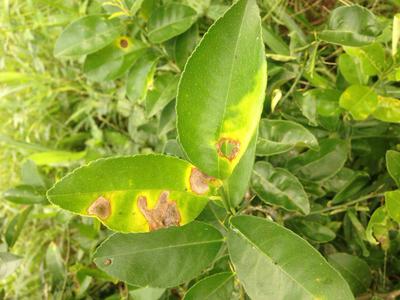Anthracnose of Citrus
Colletotrichum gloeosporioides
Fungus
In a Nutshell
- Light tan spots on leaves.
- Center of spots turns grayish.
- Small firm, dry, brown to black spots on fruits.
Can also be found in
Symptoms
Leaves display circular spots of light tan color with a prominent purple margin. The center of these spots gradually turns grayish and, in the later phases of the infection, may show tiny dispersed black flecks. Tissues injured by environmental factors (such as insect damage or otherwise inflicted lesions) are more susceptible to colonization by the anthracnose fungus. Fruits that have previously been injured by other agents like sunburn, chemical burn, pest damage, bruising, or unfavorable storage conditions, are particularly prone to develop anthracnose. Fruit symptoms are firm and dry, brown to black spots of 1,5 mm or slightly greater diameter. The spore masses growing on the lesions are usually brown to black, but under humid conditions, they can turn pink to salmon.
Recommendations

Organic Control
Bio-fungicides based on Bacillus subtilis or Bacillus amyloliquefaciens work fine if applied during favorable weather conditions. Hot water treatment of seeds or fruits (48°C for 20 minutes) can kill any fungal residue and prevent further spreading of the disease in the field or during transport. Foliar sprays or seed treatments with fungicides containing copper sulfate can be used to lower the risk of infection.

Chemical Control
Always consider an integrated approach with preventive measures together with biological treatments if available. Fungicides containing azoxystrobin or chlorothalonil can be sprayed regularly to lower the risk of infection. Seed treatment with these compounds can also be envisaged. Finally, post-harvest fungicides together with a food-grade wax can be applied to reduce the incidence of fruits bound to be shipped to overseas markets.
What caused it?
Anthracnose grows on dead wood in the canopy, and it spreads over short distances via rain splashes, heavy dew, and overhead irrigation. In this way, it reaches susceptible tissue of young leaves and fruits, and start to grow, triggering the symptoms. New batches of spores are produced on sexual structures growing on the spots and lesion on leaves and fruits. These spores may become airborne and can subsequently disperse the disease over long distances. Once the spores germinate, they form a resting structure, remaining dormant until an injury occurs or until the post-harvest treatment of the fruit (degreening for example). Optimal conditions for the growth of the fungus are very high humidity and temperature of 25-28 °C, but more generally the infection can develop at 20-30 °C.
Preventive Measures
- Select sites with low rainfalls.
- Plant resistant varieties and use healthy seeds.
- Leave sufficient space between plants.
- Plant non-host trees such as coffee in or around the field.
- Prune trees yearly to enhance ventilation.
- Remove fallen fruits and leaves from the field.
- Keep the field clear of weeds.
- Implement good drainage methods.
- Harvest early to avoid the worst symptoms.
- Store fruits in a well-ventilated environment.



